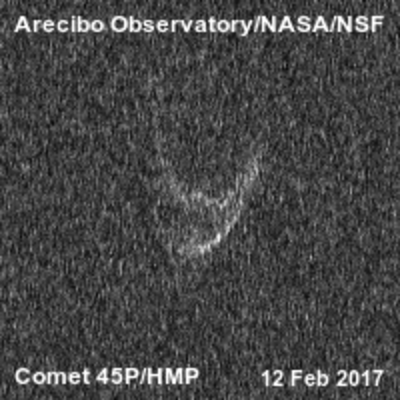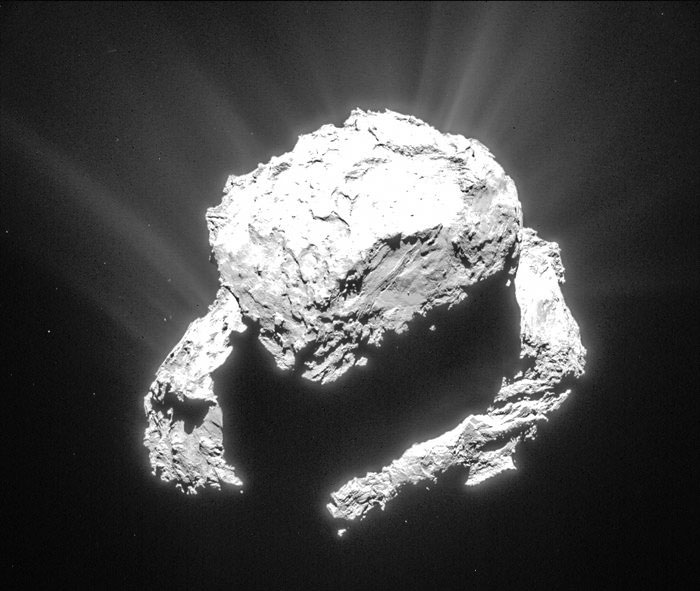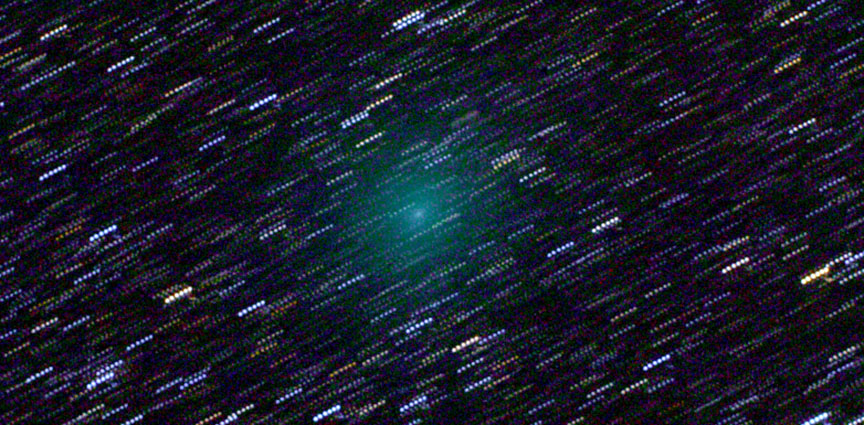
This animation of comet 45P/H-M-P is composed of thirteen delay-Doppler images made during 2 hours of observation using the Arecibo Observatory on Feb. 12. Credit: USRA
Comets hide their central engines well. From Earth, we see a bright, fuzzy coma and a tail or two. But the nucleus, the source of all the hubbub, remains deeply camouflaged by dust, at best appearing like a blurry star.
To see one up close, you need to send a spacecraft right into the comet's coma and risk getting. Or you can do the job much more cheaply by bouncing radio waves off the nucleus and studying the returning echoes to create a shadowy image.
Although crude compared to optical photos of moons and planets, radar images reveal much about an asteroid including surface details like mountains, craters, shape and rotation rate. They're also far superior to what optical telescopes can resolve when it comes to asteroids, which, as their name implies, appear star-like or nearly so in even large professional telescopes.
On Feb. 11, green-glowing comet 45P/Honda-Mrkos-Pajdusakova, made an unusually close pass of Earth, zipping just 7.7 million miles away. Astronomers made the most of the encounter by pressing the huge 1,000-foot-wide (305 meters) Arecibo radio dish into service to image the comet's nucleus during and after closest approach.

Arecibo Observatory, the world's biggest single dish radio telescope, was and is still being used to image comet 45P/H-M-P. Courtesy of the NAIC - Arecibo Observatory, a facility of the NSF
"The Arecibo Observatory planetary radar system can pierce through the comet's coma and allows us to study the surface properties, size, shape, rotation, and geology of the comet nucleus", said Dr. Patrick Taylor, USRA Scientist and Group Lead for Planetary Radar at Arecibo.

The two lobes of comet 67P/C-G stand out clearly in this photo taken by ESA's Rosetta spacecraft while in orbit about the comet on March 6, 2015. Credit: ESA/Rosetta
Does the shape ring a bell? Remember Rubber Ducky? It doesn't take a rocket scientist to see that the comet's heart resembles the twin-lobed comet 67P/Churyumov-Gerasimenko orbited by ESA's Rosetta spacecraft. Using the dish, astronomers have seen bright regions and structures on the comet; they also discovered that the nucleus is a little larger than expected with a diameter of 0.8 mile (1.3 km) and rotates about once every 7.6 hours. Go to bed at 10 and wake up at 6 and the comet will have made one complete turn.

Comet 45P is seen here on Feb. 8, 2017. While its overall brightness is about magnitude +8.5, the comet appears diffuse and rather faint. From dark skies, it remains a binocular object at least for a little while. Credit: Chris Schur
Radio observations of 45P/H-M-P will continue through Feb. 17. Right now, the comet is happily back in the evening sky and still visible with 10x50 or larger binoculars around 10-11 p.m. local time in the east. I spotted it low in Bootes last night about 15 minutes before moonrise under excellent, dark sky conditions. It looked like a faint, smoky ball nearly as big as the full moon or about 30 arc minutes across.
This week, the pale green blob (the green's from fluorescing carbon), vaults upward from Bootes, crosses Canes Venatici and zooms into Coma Berenices. For maps to help you track and find it night by night, please click here. I suggest larger binoculars 50mm and up or a 6-inch or larger telescope. Be sure to use low power — the comet's so big, you need a wide field of view to get dark sky around it in order to see this blurry blob more clearly.
Very few comets pass near Earth compared to the number of asteroids that routinely do. That's one reason 45P is only the seventh imaged using radar; rarely are we treated to such detailed views!
No comments:
Post a Comment